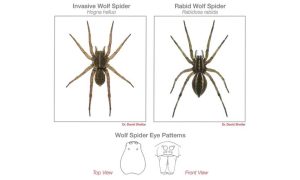Grass Spider VS Wolf Spider
The grass spider and the wolf spider are both fascinating arachnids, each with its unique characteristics. Grass spiders, belonging to the Agelenidae family, are known for their intricate funnel-shaped webs, often found in grassy areas or low vegetation. These spiders are agile hunters, relying on their webs to detect vibrations from potential prey. On the other hand, wolf spiders, members of the Lycosidae family, are ground-dwelling hunters that actively pursue their prey.
They don’t build webs for catching food but instead use their speed and agility to stalk and pounce on insects. Wolf spiders are recognizable by their robust build and excellent eyesight. While grass spiders are more discreet in their approach to hunting, utilizing webs strategically, wolf spiders are adept ambush predators that rely on their keen senses and hunting prowess. Both species play crucial roles in controlling insect populations, contributing to the delicate balance of ecosystems.
Physical Characteristics
Grass spiders, scientifically known as Agelenidae, boast elongated bodies and distinctive striped patterns. Their legs are equipped with sensitive hairs, aiding in navigation and prey detection. In contrast, wolf spiders exhibit robust bodies, often with intricate patterns, and are known for their keen eyesight.
Habitat and Distribution
Grass spiders prefer grassy areas and can be found in gardens, meadows, and fields. On the other hand, wolf spiders are adaptable and can thrive in various environments, including forests, deserts, and grasslands. Read more: Croaker Fish
Web Structure and Behavior
Grass spiders are renowned for their funnel-shaped webs, strategically positioned to capture unsuspecting insects. Conversely, wolf spiders are hunters that actively pursue their prey without relying on intricate webs.

Venom and Bites
While grass spiders possess venom, their bites are typically harmless to humans. On the other hand, wolf spiders can deliver a more potent bite, although severe reactions are rare.
Dietary Preferences
Grass spiders primarily feed on small insects ensnared in their webs, showcasing their adept trapping skills. Wolf spiders, as hunters, prey on a variety of insects and even other spiders.
Reproduction
Grass spiders reproduce through intricate courtship rituals, and females may produce multiple egg sacs. Wolf spiders, as versatile hunters, engage in mating rituals, and females carry their egg sacs attached to their abdomens. For More Interesting Information Visit Our Website: News Blinkers
Identification Tips
To distinguish grass spiders, observe their funnel webs and striped patterns. Meanwhile, identifying wolf spiders involves recognizing their robust bodies and hunting behaviors.
Common Misconceptions
Contrary to popular belief, grass spiders are beneficial for controlling insect populations, and their bites are rarely harmful. Similarly, wolf spiders, though intimidating, are generally not aggressive toward humans.
Role in Ecosystem
Grass spiders contribute to ecosystem balance by controlling insect populations, serving as natural pest controllers. Wolf spiders play a crucial role in maintaining insect diversity by preying on various species.
Interactions with Humans
While grass spiders may occasionally enter homes, they are not aggressive and pose minimal threat. Wolf spiders may also venture indoors but are generally harmless unless provoked.
Adaptations to Environment
Grass spiders have adapted their web-building techniques to suit grassy environments, showcasing their evolutionary resilience. Wolf spiders’ adaptability allows them to thrive in diverse habitats, showcasing their versatility.
Similarities and Differences
In summary, grass spiders and wolf spiders share a common arachnid heritage but differ significantly in their habitats, behaviors, and roles in the ecosystem. Understanding these nuances enriches our perspective on these fascinating creatures.
Identifying Wolf Spiders in Your Home
Wolf spiders are common arachnids that can often be found indoors, and recognizing them is essential for those looking to distinguish them from other spider species. These spiders are typically robust and covered in hair, with a distinctive eye arrangement. Unlike many other spiders, wolf spiders have two large eyes at the front, followed by two smaller eyes on the second row, and four smaller eyes forming the back row.
Their coloration can vary, but they often have a mix of gray, brown, and black hues, helping them blend into their surroundings. Additionally, wolf spiders are known for their fast and agile movements, as they actively hunt for prey rather than building webs to catch it. If you come across a spider matching this description in your home, it’s likely a wolf spider. Despite their intimidating appearance, these spiders are generally harmless to humans and play a valuable role in controlling insect populations.
Fun Facts
Some grass spiders create multiple funnel webs for different purposes, including shelter and trapping prey.
Wolf spiders, despite their name, do not hunt in packs but are solitary hunters.
Conclusion
In the intricate tapestry of nature, grass spiders and wolf spiders weave their unique stories. Appreciating these arachnids for their roles in maintaining ecological balance fosters a deeper connection with the natural world. As we navigate through landscapes, let’s remember the vital contributions of these eight-legged marvels.
FAQs
Q. Are grass spiders dangerous to humans?
A. Grass spiders are generally harmless, and their bites are not considered dangerous.
Q. Do wolf spiders live in packs like their name suggests?
A. No, wolf spiders are solitary hunters and do not form packs.
Q. What is the purpose of the funnel-shaped webs created by grass spiders?
A. Grass spiders use funnel webs for shelter and trapping prey, showcasing their versatility.
Q. Are wolf spiders beneficial to the environment?
A. Yes, wolf spiders contribute to ecosystem balance by controlling insect populations.
Q. How can I identify a wolf spider in my home?
A. Look for robust bodies and distinctive patterns to identify wolf spiders.
